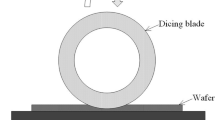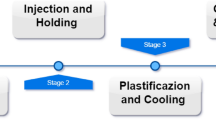Abstract
A critical aspect of wire bonding is the quality of the bonding strength that contributes the major part of yield loss to the integrated circuit assembly process. This paper applies an integrated approach using a neural networks and genetic algorithms to optimize IC wire bonding process. We first use a back-propagation network to provide the nonlinear relationship between factors and the response based on the experimental data from a semiconductor manufacturing company in Taiwan. Then, a genetic algorithms is applied to obtain the optimal factor settings. A comparison between the proposed approach and the Taguchi method was also conducted. The results demonstrate the superiority of the proposed approach in terms of process capability.
Similar content being viewed by others
References
Brainmaker (1989) Salifronic Scientific Software, Version 2.3, Sierra Madre, CA.
Chang, C. Alec and Su, C. T. (1995) A comparison of statistical regression and neural network methods in modeling measurement errors for computer vision inspection systems. Computers and Industrial Engineering, 28(3), 593-603.
Chao, P. Y. and Hwang, Y. D. (1997) An improved Taguchi's method in designing of experiments for milling CFRP composite. International Journal of Production Research, 35, 31-45.
Chen, F. L. and Liu, S. F. (2000) A neural-network approach to recognize defect spatial pattern in semiconductor fabrication. IEEE Transactions on Semiconductor Manufacturing, 13(3), 366-373.
Chen Junghui, Chu Paul P. T., Shan David, Wong Hill and Jang S. S. (1999) Optimal design using neural network and information analysis in plasma etching. Journal of Vacuum Science Technology, 17(1), 145-153.
Chiu, C. C., Su, C. T., Yang, G. S., Huang J. S., Chen, S. C. and Cheng, T. N. (1997) Selection of optimal parameters in gas-assisted injection molding using neural network model and the Taguchi method. International Journal of Quality Science, 2(2), 106-120.
Coit, D. W., Jackson, B. T. and Smith, A. E. (1998) Static neural network process model: considerations and cases studies. International Journal of Production Research, 36(11), 2953-2967.
Dabade, B. M. and Ray, P. K. (1996) Quality engineering for continuous performance improvement in products and processes: a review and reflections. Quality and Reliability Engineering International, 12, 173-189.
Fausett, L. (1994) Fundamental of Neural Networks: Architectures, Algorithms, and Applications, Prentice Hall, NJ.
Goh, T. N. (1993) Taguchi methods: some technical, cultural and pedagogical perspectives. Quality and Reliability Engineering International, 9, 185-202.
Goldberg, D. E. (1989) Genetic Algorithms in Search, Optimisation, and Machine Learning, Addision-Wesley, New York.
Himmel C. and May G. (1993) Advantages of Plasma etch modeling using neural networks over statistical techniques. IEEE Transactions Semiconductor Manufacturing, 6, 103-111.
Hsu, C. M. and Su, C. T. (1998) Multi-objective machine-component grouping in cellular manufacturing: A genetic algorithm. Production Planning and Control, 9(2), 155-166.
Hsu, H. M., Tsai, S. P., Wu, M. C. and Tzuang, C. K. (1999) A genetic algorithm for the optimal design of microwave filters. International Journal of Industrial Engineering, 6(4), 282-288.
Hung, S. L. and Adeli (1994) A parallel genetic/neural network learning algorithm for MIMD shared memory machines. IEEE Transactions on Neural Networks, 5(6), 900-909.
Kacker, R. N. (1985) Off-line quality control, parameter design and Taguchi method. Journal of Technology, 17, 176-209.
Krottmaier, J. (1993) Quality Engineering Designs, McGraw-Hill, Inc., NY.
Lee Kyeong K. and Brown Terence, Dagnall Georgianna, Bicknell-Tassius Robert, Brown, April and May, Gary S. (2000) Using neural networks to construct model of the molecular beam epitaxy process. IEEE Transactions on Semiconductor Manufacturing, 13(1), 34-45.
Liao, T. W. and Chen, L. J. (1998) Manufacturing process modeling and optimization based on multi-layer perception networks. ASME Transactions Journal of Manufacturing Science and Engineering, 120(1), 109-119.
Lipmann, R. P. (1987) An introduction to computing with neural nets. IEEE ASSP, 40.
Phadke, M. S. (1989) Quality Engineering Using Robust Design, Prentice-Hall, Englewood Cliffs, NJ.
Rich, Thomas (1999) Contemporary Research in IC Industry: Part II, SemiTech Association, San Jose, CA, 192-195.
Sette, S., Boullart, L., Langenhove, L. Van and Kiekens, P. (1997) Optimizing the fiber-to-yarn production process with a combined neural network/genetic algorithm approach. Textile Research Journal, 67(2), 84-92.
Stern, H. S. (1996) Neural networks in applied statistics. Technometrics, 38(3), 205-220.
Tay, K. M. and Butler C. (1997) Modeling and optimizing of a MIG welding process-a case study using experimental designs and neural networks. Quality and Reliability Engineering International, 13, 61-70.
Zhang, H. C. and Huang S. H. (1995) Applications of neural networks in manufacturing: a state-of-the-art survey. International Journal of Production Research, 33, 705-728.
Zurada, J. M. (1992) Introduction to Artificial Neural Systems, St. Paul, MN, West.
Author information
Authors and Affiliations
Rights and permissions
About this article
Cite this article
Su, CT., Chiang, TL. Optimizing the IC wire bonding process using a neural networks/genetic algorithms approach. Journal of Intelligent Manufacturing 14, 229–238 (2003). https://doi.org/10.1023/A:1022959631926
Issue Date:
DOI: https://doi.org/10.1023/A:1022959631926




